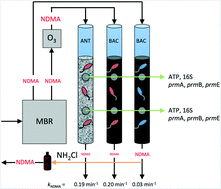N-Nitrosodimethylamine (NDMA) formation and mitigation in potable reuse treatment trains employing ozone and biofiltration†
Abstract
Ozone and chloramines are critically important for achieving stringent public health criteria and operational water quality objectives in potable reuse treatment trains, but these disinfectants are also linked to the formation of N-nitrosodimethylamine (NDMA). In the current study, a pilot-scale ozone-biofiltration system was used to treat membrane bioreactor (MBR) filtrate from a full-scale water reclamation facility. Experiments were designed to assess the roles of preoxidation, empty bed contact time (EBCT), and media type on NDMA formation and removal. In biological activated carbon (BAC) and anthracite columns receiving pre-ozonated MBR filtrate, EBCTs ≥10 min achieved >90% NDMA removal, while an EBCT of 2 min achieved only 30–40% NDMA removal. A control BAC column receiving non-ozonated MBR filtrate achieved a maximum removal of ∼45%, even with an EBCT of 20 min. Moreover, this non-ozonated BAC column still exhibited inferior performance during a short-term transition to pre-oxygenated or pre-ozonated MBR filtrate. This suggests that media conditioning with pre-ozonated MBR filtrate selected for a microbial community that was better adapted to NDMA biodegradation. The presence of monooxygenase genes and microbial taxa suspected to be involved in NDMA biodegradation was also confirmed in the biofiltration columns. When subjected to final chloramination, pre-ozonation (but not biofiltration alone) was effective in transforming NDMA precursors and reducing NDMA formation by up to 96%. Ancillary monitoring of trace organic compounds (TOrCs) also highlighted potential concerns related to the persistence of perfluoroalkyl acids (PFAAs) in potable reuse applications.



 Please wait while we load your content...
Please wait while we load your content...